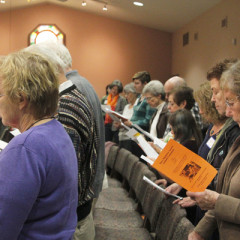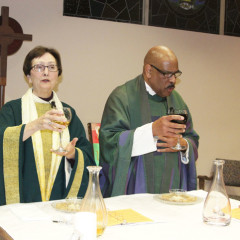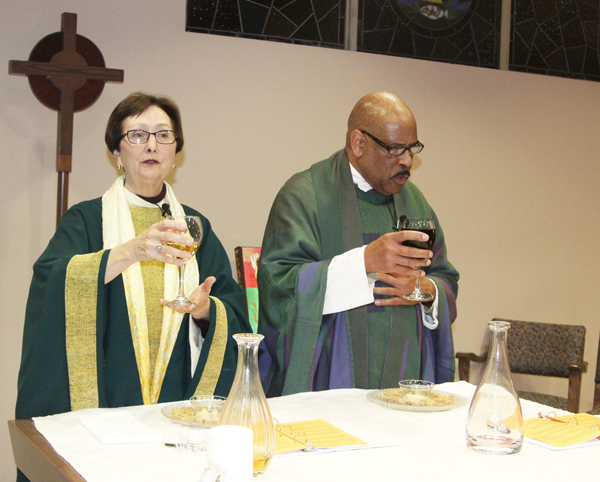(RNS) If heading a religious community is a lonely job for any woman, a Catholic Womenpriest might be the loneliest of all.
Yet the ordination of Catholic women within the Womenpriests movement, which flaunts Roman Catholic Church law forbidding the practice, continues to grow, as members demand greater inclusion of women in the institutional church.

Members of the Mary Magdalene Apostle Catholic Community gather for Mass on Jan. 20. The church is headed by Jane Via, ordained with the Catholic Womenpriests movement, and attracts progressive Catholics who have broken with the Vatican on issues including women’s ordination and birth control. Photo courtesy Megan O’Neil
The most recent ordination was on Feb. 9, in Toledo, Ohio, and five more are scheduled for 2013.
“I really believe that this is the time when we need to stand up for women’s rights in the church,” said Jeannette Love, 68, who helps lead the Catholic Church of the Beatitudes, a Womenpriests community in Santa Barbara, Calif. “Sure, it is easy for us to go to a Protestant church, but then we don’t become change agents in our own community.”
Beatitudes is one of nearly four dozen Catholic communities in the United States led by women ordained in the Roman Catholic Womenpriests movement, which celebrated its 10th anniversary last year. Its ranks now include more than 100 deacons, priests, and bishops in the U.S. and abroad.
The original members – known as the Danube Seven – were ordained in Europe in 2002 by Argentine Bishop Romulo Antonio Braschi, a progressive who broke with the Vatican in the 1970s. That ordination forms Womenpriests’ claim for legitimacy.
Subsequently, the Womenpriests have ordained each other. In 2008, church officials threatened excommunication on any woman seeking ordination, and any clergy member who assists her.
In a 2010 poll by The New York Times and CBS, however, 59 percent of American Catholics favor the ordination of women.
Support for women’s ordination as deacons is even stronger. One rung below priests in the church hierarchy, deacons can perform some functions, such as baptism.
Church law forbidding female priests is nuanced, said the Rev. James Heft, head of the Institute for Advanced Catholic Studies at the University of Southern California. It is based, in part, on “fittingness.”
“It is more appropriate for a man to play the role of Hamlet than a woman,” Heft said. “You could say that the argument is that. If the re-enactment of the Last Supper presided by Jesus is a good analogy to the Mass, than it is more appropriate that a man preside.”
There is historical evidence that women played an important role in ministry in the early church, but there is no proof they were ordained, Heft said.
“The present pope, before he became pope, offered his opinion that he thought it was an infallible teaching,” said Heft. “Strictly speaking, this could change.”
The Womenpriests movement represents one strain in a decades-old push for the ordination of women by some Catholics. Most of those ordained have advanced degrees in religious studies or theology, and years of experience in ministry, including stints as members of Catholic religious orders.
The movement attracts Catholics who have broken with the Vatican on issues beyond women’s ordination, including homosexuality, birth control and married priests. Most are of retirement age, although there are some young families.

Jane Via, 65, a retired San Diego county prosecutor, celebrates mass with Dr. Jon Connor at Mary Magdalene Apostle Catholic Community in San Diego on Jan. 20. Via was ordained within the Catholic Womenpriests movement, which flaunts church law forbidding women’s ordination. Photo courtesy Megan O’Neil
“What impressed me most was its aggressive inclusiveness,” said Mike Crowley, 66, a member of the Mary Magdalene Apostle Catholic Community in San Diego. “Not just (with) women; they aggressively include all the people that the church is doing its best to drive out – young divorced people, gays and lesbians.”
Jane Via, a retired prosecutor who heads Mary Magdalene, acknowledged that Womenpriests have done little to trigger dialogue at the institutional level.
After being ordained a deacon in 2004 and a priest in 2006, she lost access to most clergy friends. They are too angry or too scared to maintain the relationship, Via said. Her congregation, like other Womenpriests communities, rents space in a Protestant church.
“It is a huge justice issue,” Via said. “It is not just about getting women ordained in the Catholic Church, it is about changing the Catholic Church so that gender equality pervades it.”
Members of the Womenpriests movement said they are hopeful that the election of Pope Francis will mean a renewal of pastoral church leadership.
“We look forward to the birth of a new era that promotes the inclusion of the voices of women, the poor and all others marginalized by society,” the organization said in a statement on its website.
In Santa Barbara, the Catholic Church of the Beatitudes is small – regular Mass attendance tops at about 35 people – but steady, Love said.
“Our saying is we are here and we are not going away,” Love said. “My hope and dream is that we will continue to grow, not only in numbers, but in depth.”





